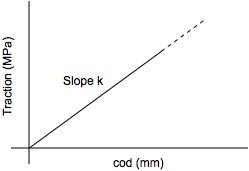Difference between revisions of "Linear Traction Law"
Jump to navigation
Jump to search
(Created page with "__TOC__ == The Traction Law == This traction law applies a linearly increasing stress and it never fails. == Failure == This traction does not fail; as CO...") |
|||
| (11 intermediate revisions by the same user not shown) | |||
| Line 3: | Line 3: | ||
This [[Traction Laws|traction law]] applies a linearly increasing stress and it never fails. | This [[Traction Laws|traction law]] applies a linearly increasing stress and it never fails. | ||
[[File:Linear.jpg|center]] | |||
== Failure == | == Failure == | ||
This traction does not fail; as COD increases, the traction | This traction does not fail or release energy; as COD increases, the traction keeps increasing. If you want to model failure, use a [[Triangular Traction Law|trangular traction law]] instead. For example, to model a linear law that suddenly drops to zero stress at some critical COD, use a [[Triangular Traction Law|trangular traction law]] with the same elastic slope, enter the critical COD (δ<sub>c</sub>), and set its [[Triangular Traction Law#Traction Law Properties|delpkI and/or delpkII parameters]] to 1. The toughness of this law would be | ||
| |||
<math>J_c = {1\over 2} k \delta_c^2</math> | |||
== Traction Law Properties == | == Traction Law Properties == | ||
| Line 16: | Line 21: | ||
! Property !! Description !! Units !! Default | ! Property !! Description !! Units !! Default | ||
|- | |- | ||
| | | kIe || The elastic slope, k, in mode I || [[ConsistentUnits Command#Legacy and Consistent Units|pressure/length units]] || 0 | ||
|- | |- | ||
| | | kIIe || The elastic slope, k, in mode II || [[ConsistentUnits Command#Legacy and Consistent Units|pressure/length units]] || 0 | ||
|} | |} | ||
== Traction History Variables == | |||
This material tracks no history variables. | |||
Latest revision as of 22:07, 2 January 2021
The Traction Law
This traction law applies a linearly increasing stress and it never fails.
Failure
This traction does not fail or release energy; as COD increases, the traction keeps increasing. If you want to model failure, use a trangular traction law instead. For example, to model a linear law that suddenly drops to zero stress at some critical COD, use a trangular traction law with the same elastic slope, enter the critical COD (δc), and set its delpkI and/or delpkII parameters to 1. The toughness of this law would be
[math]\displaystyle{ J_c = {1\over 2} k \delta_c^2 }[/math]
Traction Law Properties
The following properties are used to create a linear traction law:
| Property | Description | Units | Default |
|---|---|---|---|
| kIe | The elastic slope, k, in mode I | pressure/length units | 0 |
| kIIe | The elastic slope, k, in mode II | pressure/length units | 0 |
Traction History Variables
This material tracks no history variables.
